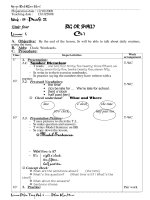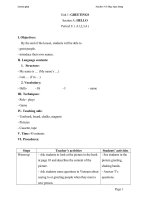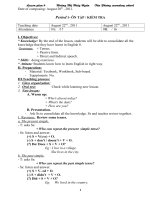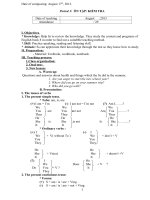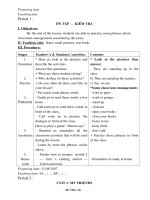Giáo án Tiếng Anh 6 cả năm 3 cột
Bạn đang xem bản rút gọn của tài liệu. Xem và tải ngay bản đầy đủ của tài liệu tại đây (741.23 KB, 276 trang )
Lesson plan Teacher: Voõ Thuïy Ngoïc Dung
Unit 1: GREETINGS
Section A: HELLO
Period: 1 ( A1,2,3,4 )
I. Objectives:
By the end of the lesson, students will be able to
- greet people.
- introduce their own names.
II. Language contents:
1. Structure:
- My name is … (My name’s …)
- I am … (I’m …)
2. Vocabulary:
- Hello - Hi - I - name
III. Techniques:
- Role - plays
- Game
IV. Teaching aids:
- Textbook, board, chalks, magnets
- Pictures
- Cassette, tape
V. Time: 45 minutes
VI. Procedures:
Steps Teacher’s activities Students’ activities
Warm-up - Ask students to look at the picture in the book
at page 10 and describes the content of the
picture.
- Ask students some questions in Vietnam about
saying to or greeting people when they meet a
new person.
- See students in the
picture greeting,
shaking hands.
- Answer T’s
questions.
Page 1
Lesson plan Teacher: Voõ Thuïy Ngoïc Dung
- Ask students how to introduce themselves
when they meet a new person.
A1
Presentation
A2
Practice
- Ask students to listen to the tape.
“Hello” , “Hi”
- Ask students to listen again then repeat.
- Ask students to practice and work in pairs.
- Ask some pairs to say greetings before the
class.
- Correct their pronunciation.
* NEW WORDS:
- hello (interj) [hə'lou] → formal style
- hi (interj) [hai] → informal style
- classmate (n) ['klɑ:smeit]
- Listen to the tape.
- Listen again and
repeat
- Work in pairs.
A3
Presentation
Practice
Controlled
- Tell students two ways to introduce their
names :
* NEW STRUCTURE:
I am + name.
My name is + name.
- Give the brief form of these ways:
I’m + name.
My name’s + name.
- Ask students to listen to the tape and then
repeat.
- Ask some students to play role Lan, Nga, Ba,
Nam before the class.
- Correct their pronunciation.
- Write these
structures on their
notebooks
- Listen to the tape.
- Repeat in chorus.
- Play role.
I am Lan.
I am Nga.
My name is Ba.
Page 2
Lesson plan Teacher: Voõ Thuïy Ngoïc Dung
Further
practice
- Ask students to practice with a group of four.
- Ask them to introduce their names one by one.
- Correct their pronunciation.
* NEW WORDS:
- name (n) [neim]
My name is Nam.
- Work in groups.
Consolidation - Recall students how to greet people.
- Use question: “What’s your name?” to help
students remember two ways to answer.
- Game: MY NAME
Procedures:
- Ask students to write theirs name on a paper.
- Disorder these paper and give them to
students.
- Ask one student read aloud the name on the
paper.
- The student whose name is announced stands
up and read his paper.
- Let the game go on till the end of the period.
- Answer T’s
questions.
- Play game.
- Follow T’s
instructions.
HOMEWORK:
- Learn the ways to greet people and introduce name.
Page 3
Lesson plan Teacher: Voõ Thuïy Ngoïc Dung
Unit 1: GREETINGS
Section A: HELLO
Period: 2 ( A5,6,7 )
I. Objectives:
By the end of the lesson, students will be able to
- greet another.
- ask how people are.
- express one’s gratitude.
II. Language contents:
1. Structure:
- How are you?
- I’m fine, thanks. / I’m fine, thank you.
- And you?
2. Vocabulary:
- fine (a) - Mr. (n) - Miss (n)
III. Techniques:
- Role - plays
- Game
IV. Teaching aids:
- Textbook, board, chalks, magnets
- Pictures
- Cassette, tape
V. Time: 45 minutes
VI. Procedures:
Steps Teacher’s activities Students’ activities
Warm-up - Game: Throw And Catch
Procedure:
- Use a small soft ball and throw it to students.
- Ask students that receive the ball to say:
- Play game.
Page 4
Lesson plan Teacher: Voõ Thuïy Ngoïc Dung
Hello / Hi
I’m + name. / My name’s + name.
then throw it to another person and go on.
- Ask students do it as quickly as they can. If
somebody can’t do it quickly being the loser.
- Ask the loser to sing a song.
A5
Presentation
- Stick the picture on the board.
- Introduce the dialogue.
- Ask students to listen to the tape.
- Teach new words and structure.
* NEW WORDS:
- how (adv) [hau]
- fine (a): [fain]
- thanks (interj) ['θæηks]
* NEW STRUCTURE:
How are you?
- I’m fine, thanks.
- I’m fine, thank you.
- Ask students to listen to tape again with
pauses after two sentences and repeat.
- Ask students to practice reading the dialogue
in pairs.
- Ask some pairs to perform before the class.
- Correct their pronunciation.
- Listen to the tape.
- Write new words and
structure on their
notebooks.
- Listen to the tape.
- Repeat in chorus.
- Work in pairs.
A6
Practice
* NEW WORDS:
- Mr. (n) ['mistə] ] → formal style
- Miss (n) ['miz] ] → formal style
- Write new words on
their notebooks.
Page 5
Lesson plan Teacher: Voõ Thuïy Ngoïc Dung
- Ask students to look at two pictures on their
books at page 12 and read people‘s names in
pictures.
- Ask students to make the similar dialogues
as part 5 with people in part 6 in pairs.
- Ask some pairs to perform before the class.
- Correct their pronunciation.
- Read names of people
in pictures.
- Make the similar
dialogues in pairs.
A7
Practice
- Ask students to look at the dialogue in part 7
at page 13 then complete it
- Ask students to compare with their partners
- Ask some students to read their answers
before the class.
- Check their errors.
- Ask these students to write their answers on
the board and the others write them on their
notebooks.
- Complete part 7 at
page 13.
- Compare with their
partners.
- Write answers.
Consolidation - Ask students to fill in the blanks.
Hoa: ………………………….
My ……………… is
Hoa.
Nga: ………………………….
……………… am Nga.
How are ……………… ?
Hoa: I’m ………………,
thanks.
……………… you?
Nga: I’m fine,
………………………
- Fill in the blanks.
Suggested keys:
Hoa: Hi, Nga.
My name is
Hoa.
Nga: Hello, Hoa.
I am Nga.
How are you?
Hoa: I’m fine, thanks.
And you?
Nga: I’m fine, thanks.
Page 6
Lesson plan Teacher: Voõ Thuïy Ngoïc Dung
HOMEWORK:
- Learn new words and new structure.
- Do exercises from 1 to 4 at page (4, 5) in workbook.
Page 7
Lesson plan Teacher: Voõ Thuïy Ngoïc Dung
Unit 1: GREETINGS
Section B: GOOD MORNING
Period: 3
I. Objectives:
By the end of the lesson, students will be able to
- greet in different time of the day.
- say good bye.
II. Language contents:
* Vocabulary:
- Good morning - Good afternoon - Good evening
- Good night - Good bye - Bye
III. Techniques:
- Role - plays
- Game
IV. Teaching aids:
- Textbook, board, chalks, magnets
- Pictures
- Cassette, tape
V. Time: 45 minutes
VI. Procedures:
Steps Teacher’s activities Students’ activities
Warm-up - Ask students to tell the ways of greeting.
- Stick pictures on the board and ask students
to guess what part of the day it is.
- Say “Hello”, “Hi”
- Watch pictures and
guessing.
B1
Presentation
- Ask students to listen to the tape and guess
what part of the day it is.
- Call some students say their guesses.
- Correct their answers.
- Listen to the tape.
Page 8
Lesson plan Teacher: Voõ Thuïy Ngoïc Dung
* NEW WORDS:
- morning (n) ['mɔ:niη]
→ Good morning: 0 12 am
- afternoon (n) ['ɑ:ftənu:n]
→ Good afternoon: 12 pm 6 pm
- evening (n) [i':vniη]
→ Good evening: 6 pm 12 pm
- night (n) [nait]
→ Good night
- Good bye
- Bye [bai]
- Write new words on
their notebooks.
B2
Practice
- Ask students to listen again and repeat.
- Ask some students to read before the class.
- Give them different situations and ask them
to practice.
- Ask students to practice with their partners.
- Ask some pairs to perform before the class.
- Correct their pronunciation.
- Listen to the tape
again.
- Repeat in chorus.
- Work in pairs.
B3
Practice
- Ask students to listen to the dialogue in B3
twice.
- Ask students to repeat in chorus.
- Ask students to practice the dialogue in
pairs.
- Ask some pairs to perform before the class.
- Correct their pronunciation.
- Listen to the tape
- Repeat in chorus.
- Work in pairs.
B4
Practice
Consolidation
- Ask students to complete the dialogue at
page 16.
- Ask students to compare with their partners.
- Ask some students to read their answers
before the class.
- Complete part 4 at
page 16.
- Compare with their
partners.
- Write answers.
Page 9
Lesson plan Teacher: Voõ Thuïy Ngoïc Dung
- Check their errors.
- Ask these students to write their answers on
the board and the others write them on their
notebooks.
- Game: Pelmanism
Procedures:
- Make some cards having two faces like this:
- Let ss choose one card, they will see the
number and say it.
Suggested keys:
Lan: Good afternoon.
Nga.
Nga: Good afternoon,
Lan.
Lan: How are you?
Nga: I am fine,
thanks.
And you?
Lan: Fine, thanks.
Nga: Goodbye.
Lan: Bye.
HOMEWORK:
- Learn new words
- Do exercises from 1 to 3 at page (6,7) in workbook.
Page 10
eleven 11
Lesson plan Teacher: Voõ Thuïy Ngoïc Dung
Unit 1: GREETINGS
Section C: HOW OLD ARE YOU?
Period: 4 (C1,2)
I. Objectives:
By the end of the lesson, students will be able to
- count to twenty.
II. Language contents:
* Vocabulary:
One, two, three, four, five, six, seven, eight, nine, ten, eleven, twelve, thirteen, fourteen,
fifteen, sixteen, seventeen, eighteen, nineteen, twenty
III. Techniques:
- Game
IV. Teaching aids:
- Textbook, board, chalks, magnets
- Pictures
- Cassette, tape
V. Time: 45 minutes
VI. Procedures:
Steps Teacher’s activities Students’ activities
Warm-up - Ask students to look at the picture on page
17.
- Ask students to count how many students are
in the picture.
- Saying: “Four students”
- Answer T’s question.
C1
Presentation
- Ask students to listen to the tape and repeat.
- Write numbers from one to twenty on the
board.
- Read these numbers and asking students
repeat.
- Listen to the tape.
- Repeat in chorus.
- Write numbers on
their notebooks.
- Repeat in chorus.
Page 11
Lesson plan Teacher: Voõ Thuïy Ngoïc Dung
C2
Practice
- Game: “Rub Out And Remember”
Procedures:
- Erase some numbers and ask students to
recall.
- Ask students rewrite some erased numbers.
- Ask a pair to go to the board.
+ The first says in English.
+ The second writes them on the board.
- Ask students to practice counting from one
to twenty.
- Correct their pronunciation.
- Play game.
- Work in pair.
Consolidation - Game: “Slap The Board”
Procedures:
- Write some numbers on the board.
- Ask the representative of each group to go to
the board.
- Say numbers and students have to slap the
numbers on the board.
- Choose the fastest to be the winner.
- Ask students to count from one to twenty
again.
- Game: Lucky numbers
Procedures:
- T writes some numbers and choose two
lucky ones.
- Ask ss to choose one number, if it is not a
lucky number, T gives a question to ss
- Play game.
- Count from one to
twenty again.
HOMEWORK:
- Learn numbers from one to twenty.
Page 12
Lesson plan Teacher: Voõ Thuïy Ngoïc Dung
Unit 1: GREETINGS
Section C: HOW OLD ARE YOU?
Period: 5 (C3,4)
I. Objectives:
By the end of the lesson, students will be able to
- introduce the others.
- say how old one is.
II. Language contents:
1. Structure:
- This is Phong.
- How old are you?
- I’m twelve.
2. Vocabulary:
- this - year(s) old
III. Techniques:
- Role-plays
- Game
IV. Teaching aids:
- Textbook, board, chalks, magnets
- Pictures
- Cassette, tape
V. Time: 45 minutes
VI. Procedures:
Steps Teacher’s activities Students’ activities
Warm-up - Game: “Jumbled Words”
Procedures:
- Give each group a worksheet like this:
1. wlete →
- Play game
Suggested keys:
1. twelve
Page 13
Lesson plan Teacher: Voõ Thuïy Ngoïc Dung
2. tefinfn →
3. nelvee →
4. rteehint →
5. eefturo →
6. itehg →
7. netwyt →
8. etnvesne →
- Ask each groups rearrange these words into
right words.
- Choose the fastest to be the winner.
2. fifteen
3. eleven
4. thirteen
5. fourteen
6. eight
7. twenty
8. seventeen
C3
Presentation
- Ask some students about their ages in
Vietnamese.
- Ask students to listen to the tape twice with
pauses and then repeat.
- Ask some students to play roles and perform
before the class.
- Teach students how to introduce the others.
- Write the structure:
This is + name
on the board
- Give some examples:
Ex: This is Dung.
This is Hoa.
- Ask students to practice in groups
- Ask some students to performs before the
class.
- Correct their pronunciation.
- Teach students how to ask one’s age.
- Write the structure:
- Answer T’s question.
- Listen to the tape.
- Repeat in chorus.
- Play roles.
Page 14
Lesson plan Teacher: Voõ Thuïy Ngoïc Dung
How old are you?
I’m + number.
on the board.
- Give some examples:
Ex: How old are you?
I’m eleven.
- Ask students to work in pairs and use this
structure.
- Ask some pairs to perform before the class
- Correct their pronunciation.
HOMEWORK:
- Learn new structure.
- Do exercise from 1 to 4 on page (7,10) of workbook.
Page 15
Lesson plan Teacher: Voõ Thuïy Ngoïc Dung
Unit 2: AT SCHOOL
Section A: COME IN
Period: 1
I. Objectives:
By the end of the lesson, students will be able to
- use some simple imperative sentences.
- give and obey orders
II. Language contents:
* Vocabulary:
- come (v) come in - open (v) - close (v)
- sit (v) sit down - book (n) - say (v)
- stand (v) stand up
III. Techniques:
- Role-plays
- Game
IV. Teaching aids:
- Textbook, board, chalks, magnets
- Pictures
- Cassette, tape
V. Time: 45 minutes
VI. Procedures:
Steps Teacher’s activities Students’ activities
Warm-up - Review old lesson by asking some students.
- Use some questions in Unit 1
+ Hi, Nam.
+ Good morning.
+ My name is Nga.
+ How are you?
- Do as T asks.
A1 - Ask students to look at the pictures in A1 on - Look at the pictures
Page 16
Lesson plan Teacher: Voõ Thuïy Ngoïc Dung
Presentation page 20 and guess what the teacher requests.
- Ask students to listen to the tape twice.
- Ask some students to repeat the imperatives
sentences.
- Use gestures to help students find the meaning
of these sentences.
- Write the new words on the board.
VOCABULARY:
- come (v) come in
- open (v)
- close (v)
- sit (v) sit down
- book (n)
- say (v)
- stand (v) stand up
- Ask students read them and checking their
pronunciation.
- Ask students to play the game “Rub out and
remember” with the imperatives sentences on
the board.
Procedure:
- T will erase one word one by one.
- Ss have to remember them
- After that, T will ask one student to recall
them.
and do as T asks.
- Listen to the tape.
- Guess the meaning.
- Write news words on
the notebooks.
- Play game “Rub out
and remember”
A2
Practice
- Ask students to listen and do with the
imperatives sentences:
+ Stand up.
+ Sit down.
- Listen and do as T
asks.
- Work in groups.
- Do exercise A2.
Page 17
Lesson plan Teacher: Voõ Thuïy Ngoïc Dung
+ Open your book.
+ Close your book.
- Ask students to do in groups.
- Ask students to look at the pictures and do
exercises in A2 on page 21.
- Asking some students to stand up and take
turns to play role before the class.
- Ask students to play game “Simon says” in
A3 on page 22.
Procedures:
- When T says “Simon says, stand up.”, all
students have to do ask the request.
- But T just says “Stand up”, students needn’t
do as he says.
- T uses some imperatives sentences to do that
game.
Suggested keys:
a. Open your book.
b. Sit down.
c. Come in.
d. Close your book.
e. Stand up.
- Play game “Simon
says”.
HOMEWORK:
- Learn by heart the imperatives sentences.
Page 18
Lesson plan Teacher: Voõ Thuïy Ngoïc Dung
Unit 2: AT SCHOOL
Section B: WHERE DO YOU LIVE?
Period: 2 (B1,B2,B3)
I. Objectives:
By the end of the lesson, students will be able to
- ask and answer about the name.
- ask and answer about address, accommodation.
- read the alphabet
II. Language contents:
1. Vocabulary:
what where street (n)
house (n) city (n) live (v)
2. Grammar:
+ Where do you live?
- I live on … street.
+ How old are you?
- I am ....years old
III. Techniques:
- Role-plays
- Game
IV. Teaching aids:
- Textbook, board, chalks, magnets
- Pictures
- Cassette, tape
V. Time: 45 minutes
VI. Procedures:
Steps Teacher’s activities Students’ activities
Warm-up - Ask students to play the game “Hangman” - Play game
Page 19
Lesson plan Teacher: Voõ Thuïy Ngoïc Dung
with the words: come in , sit down, stand up ,
open your book…
Procedures:
- T draws some short lines on the board
- T gives some clues such as how many letters
and asks students to guess the word.
- If students doesn’t say correct the word, the
teacher will erase one line and go on.
- Students have eight chances to guess.
“Hangman”.
B1
Presentation
- Ask students to look at the pictures on page 23
and guess it is a city or a countryside.
- Explain and state that this is a city ( because
there are manly trees and building in the
pictures.)
- Ask students to tell what people often say
when they first meet each other.
- Ask students to listen to the tape to know how
to ask and answer about the name and address in
English.
- Open the tape three times with pauses.
- Ask students to repeat in chorus.
- Write new words on the board.
VOCABULARY:
- live (v)
- street (v)
- what
- where
- house (n)
- city (n)
- Look at the picture
and guess.
- Say these sentences
in Vietnamese.
- Listen to the tape.
- Repeat.
- Write new words on
their notebooks.
Page 20
Lesson plan Teacher: Voõ Thuïy Ngoïc Dung
STRUCTURES:
+ Where do you live?
- I live on .....street
+ How old are you?
- I am ....years old
Practice - Ask students to practice these structures.
- Ask students to make a survey according to
this form:
Name Street City
- Ask students to use these structures:
+ What’s your name?
+ Where do you live?
+ How old are you?
- Call some students to perform before the class.
- Correcting their errors ( if they have ).
- Practice new
structures.
- Take a survey with
other students.
- Show their surveys in
front of the class.
Presentation - Give a question: “In Vietnam, it has 29 but in
England, it has only 26.”
- Introduce the alphabet.
- Ask students to listen to the alphabet.
- Ask students to repeat in chorus
- Note on some difficult letters: G, H, J, U, W ,
X, Y, Z, E, I
- Try to guess
KEY: the alphabet
- Listen to the tape.
Practice - Ask students to play the game “Slap the - Play game
Page 21
Lesson plan Teacher: Voõ Thuïy Ngoïc Dung
board”
Procedure:
- T draws some circles like this.
- T asks some students to go to the board.
- T says letters and student have to slap the
circle.
HOMEWORK:
- Learn new structure and words
- Learn by heart the alphabet
Page 22
A
E
E Y
W G
R H J
Lesson plan Teacher: Voõ Thuïy Ngoïc Dung
Unit 2: AT SCHOOL
Section B: WHERE DO YOU LIVE?
Period: 3 (B4, B5)
I. Objectives:
By the end of the lesson, students will be able to
- ask someone to spell the name or words
II. Language contents:
1. Vocabulary:
spell (v)
2. Grammar:
- How do you spell it?
III. Techniques:
- Role-plays
- Game
IV. Teaching aids:
- Textbook, board, chalks, magnets
- Pictures
- Cassette, tape
V. Time: 45 minutes
VI. Procedures:
Steps Teacher’s activities Students’ activities
Warm-up - Show a game “Shark attack” to help student
to remember old lesson.
Procedures:
- T draws some small lines like this:
___ ___ ___ ___ ___ (eight)
___ ___ ___ ___ (city)
___ ___ ____ ____ ____ ____ (street)
- T asks students try to guess the word by using
- Play game.
Page 23
Lesson plan Teacher: Voõ Thuïy Ngoïc Dung
the alphabet.
Presentation - Ask students to look at the pictures in B4 on
page 25 and introducing the situation
- Ask students to listen to the tape.
- Call some pairs to perform before class.
- Notice the ways to spell.
- Do as T asks.
Practice - Ask students to spell their names in pairs
- Ask some pairs to spell their names before
class.
- Correct their pronunciation.
- Ask students to ask and answer the questions
in B5 on page 25 in pairs.
- Ask some pairs to ask and answer before class
- Some students go to the board and write their
answers.
- Work in pairs.
Consolidation - Show a game “Noughts and crosses”
Procedures:
- T draws a table like this:
book come sit
name live open
student old spell
- T divides class into some small groups.
- These groups have to make sentences with the
words on the table.
- Each right sentence will get “O”, each wrong
sentence will get “X”.
- What groups having 3 “O” will be the winner.
- Play game.
HOMEWORK:
- Learn new words and new structure
- Write the answer of B5 on the notebook.
Page 24
Lesson plan Teacher: Voõ Thuïy Ngoïc Dung
Unit 2: AT SCHOOL
Section C: MY SCHOOL
Period: 4 (C1)
I. Objectives:
By the end of the lesson, students will be able to
- identify objects and people.
II. Language contents:
1. Vocabulary:
- teacher (n) - student (n) - class (n)
- classroom (n) - desk (n) - school (n)
- my - your
2. Grammar:
- This is my + N
- That is my + N
- Is that your + N? Yes / No
III. Techniques:
- Role-plays
- Game
IV. Teaching aids:
- Textbook, board, chalks, magnets
- Pictures
- Cassette, tape
V. Time: 45 minutes
VI. Procedures:
Steps Teacher’s activities Students’ activities
Warm-up - Ask students to sing the English alphabet song.
- Ask students to spell name of some famous
people or soccer players.
- Do as T asks.
Presentation - Ask students to look at the pictures on page - Answer T’s
Page 25


